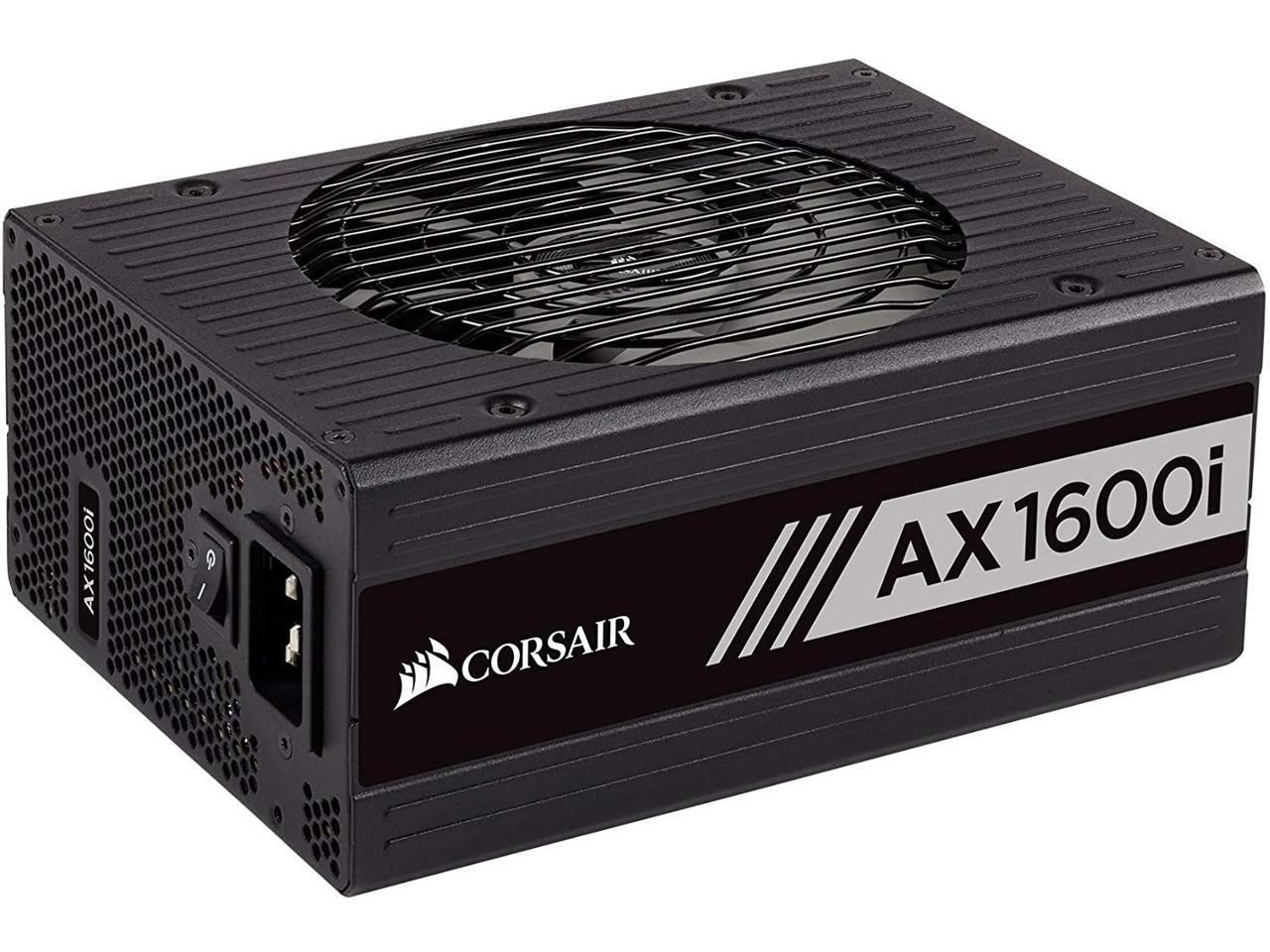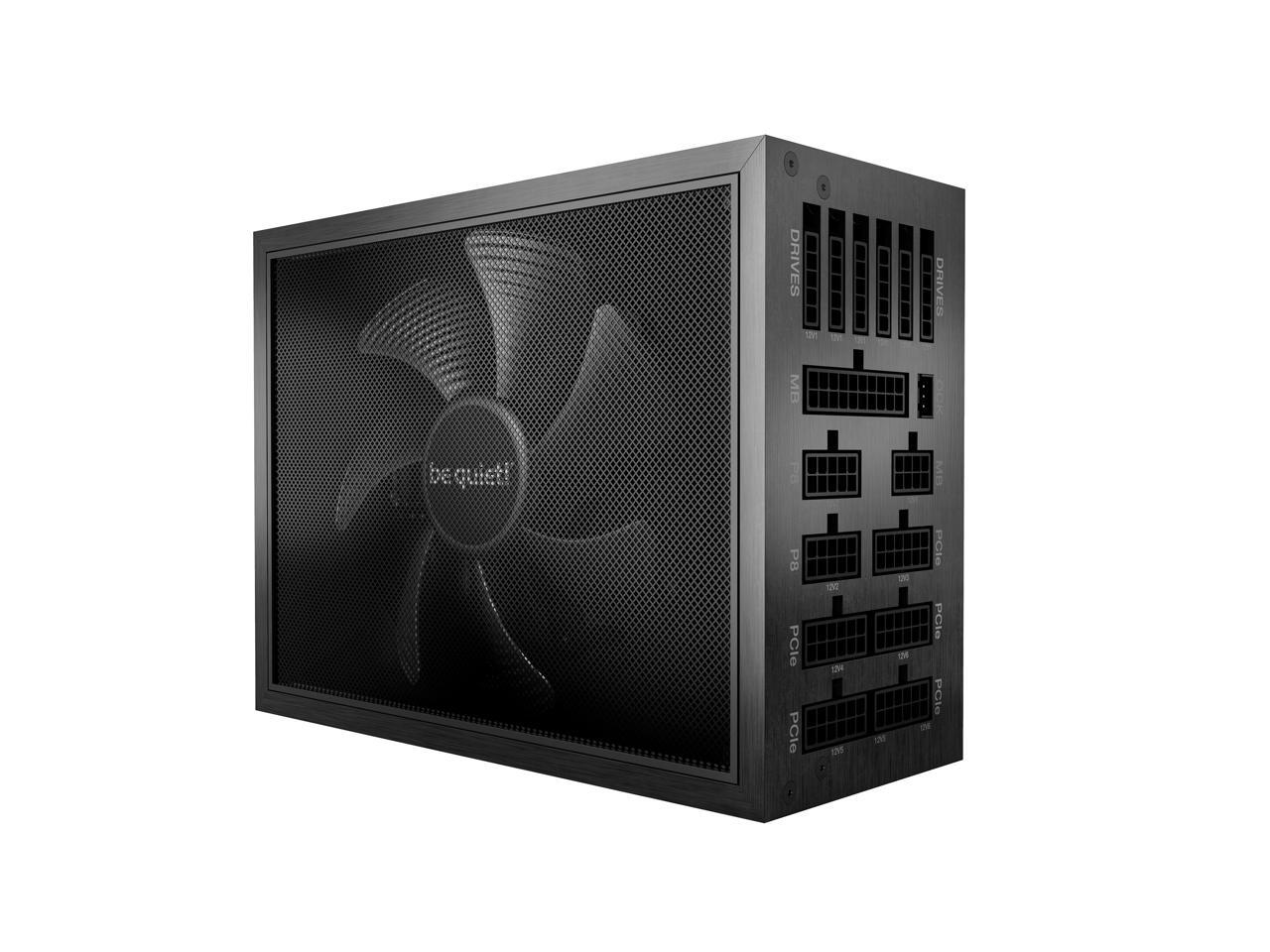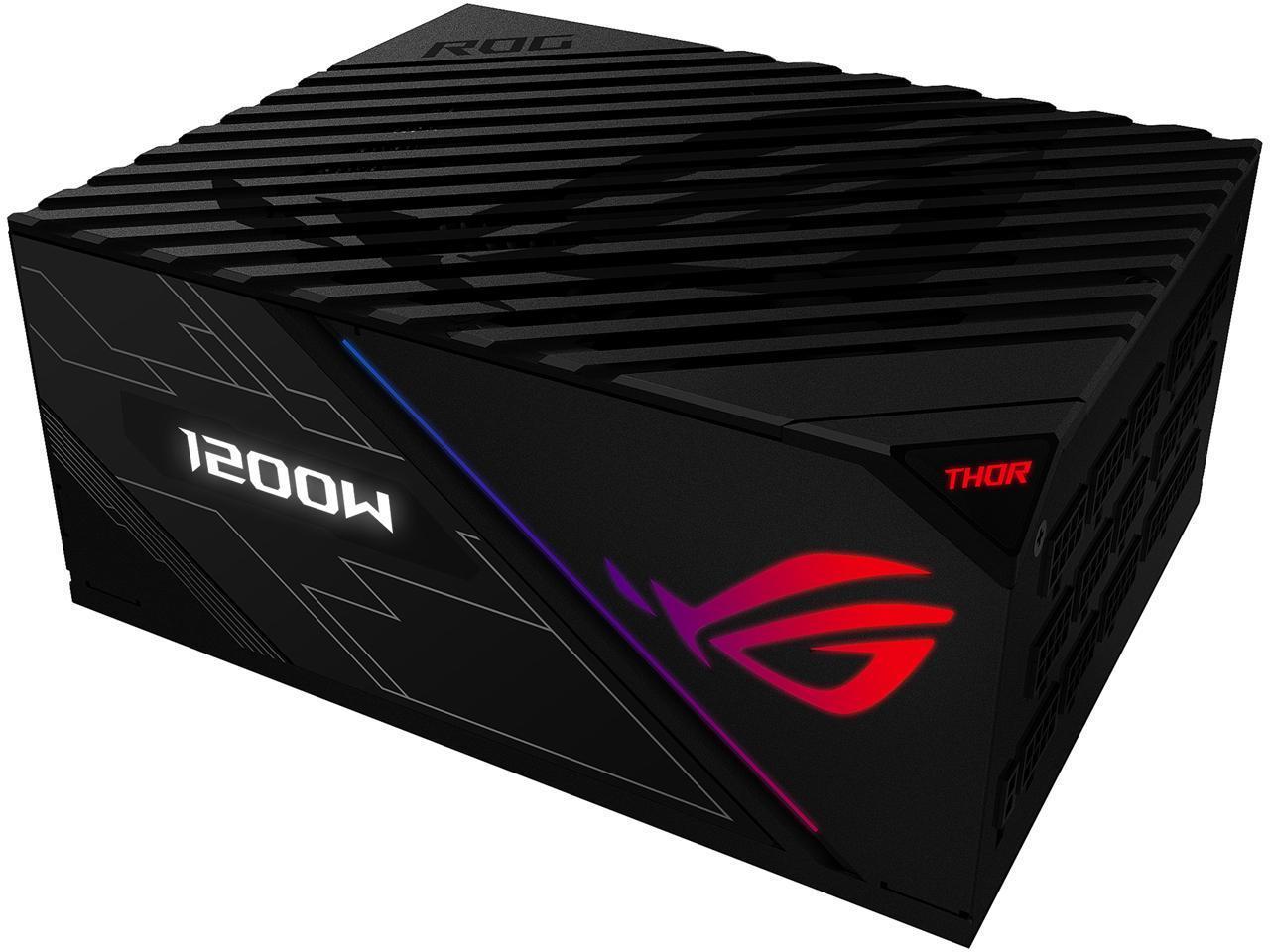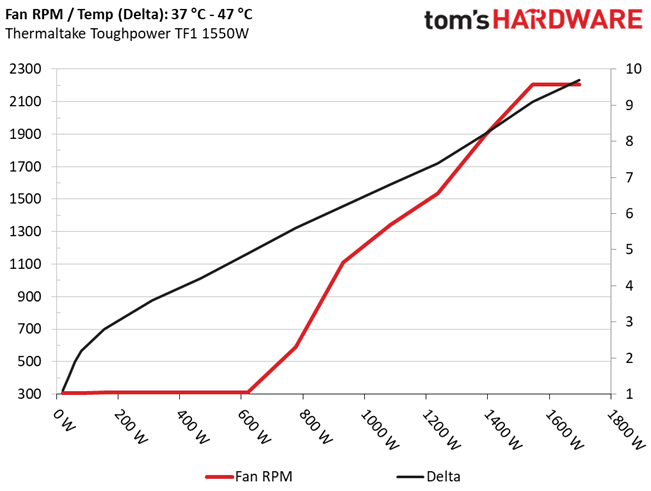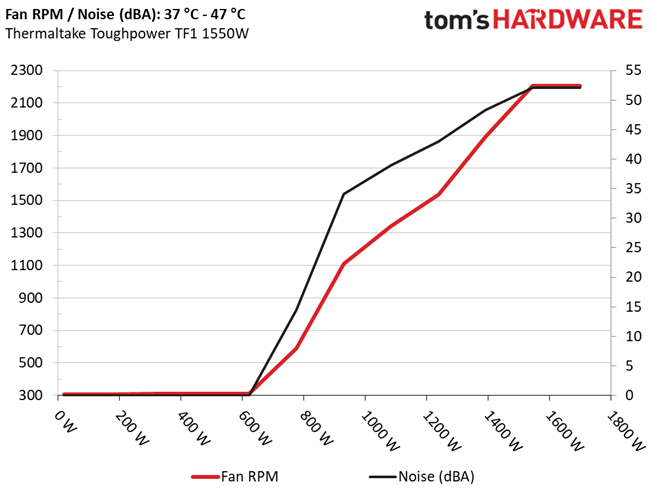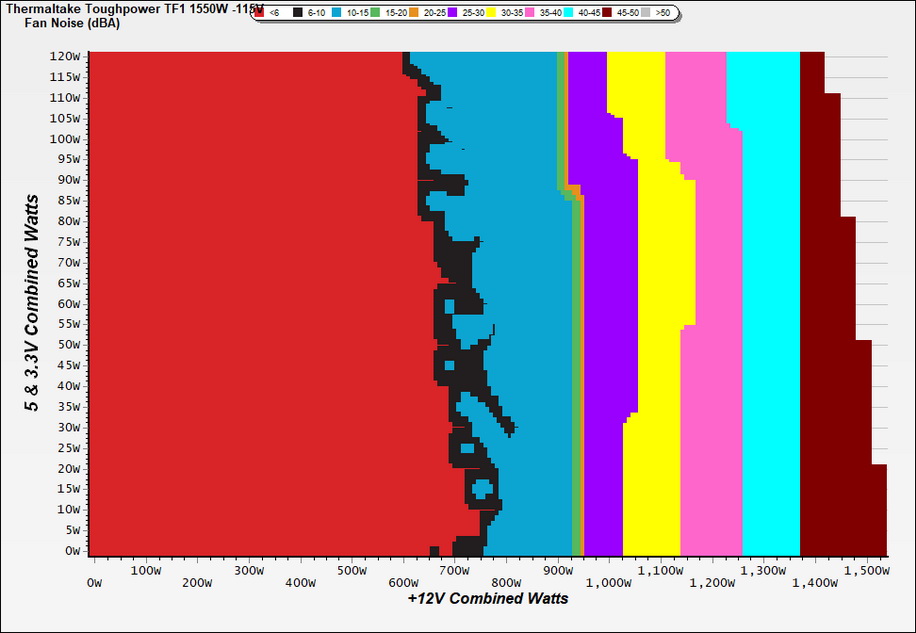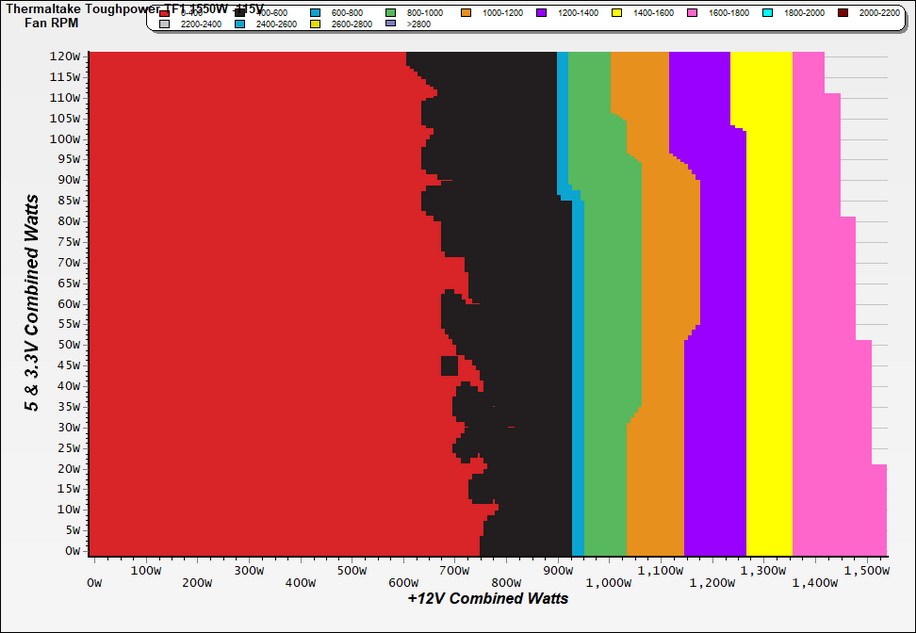Why you can trust Tom's Hardware
To learn more about our PSU tests and methodology, please check out How We Test Power Supply Units.
Primary Rails And 5VSB Load Regulation
The following charts show the main rails' voltage values recorded between a range of 40W up to the PSU's maximum specified load, along with the deviation (in percent). Tight regulation is an important consideration every time we review a power supply, as it facilitates constant voltage levels despite varying loads. Tight load regulation also, among other factors, improves the system’s stability, especially under overclocked conditions. At the same time, it applies less stress to the DC-DC converters that many system components utilize.
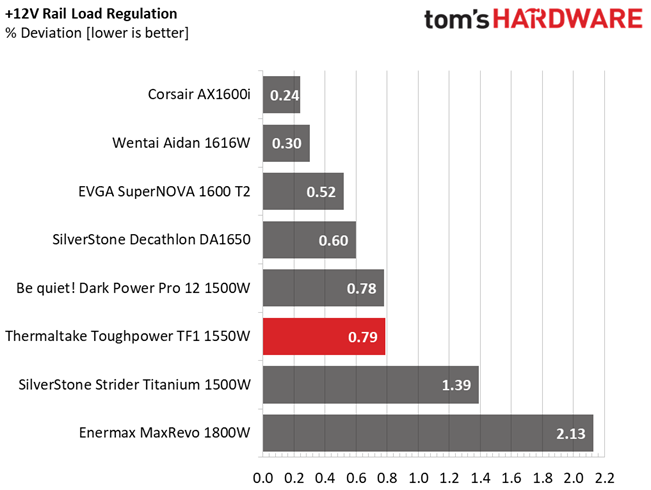
Results 1-8: Load Regulation
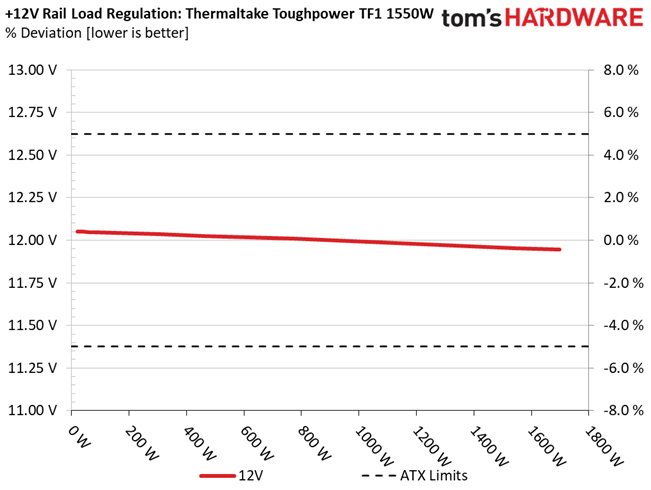

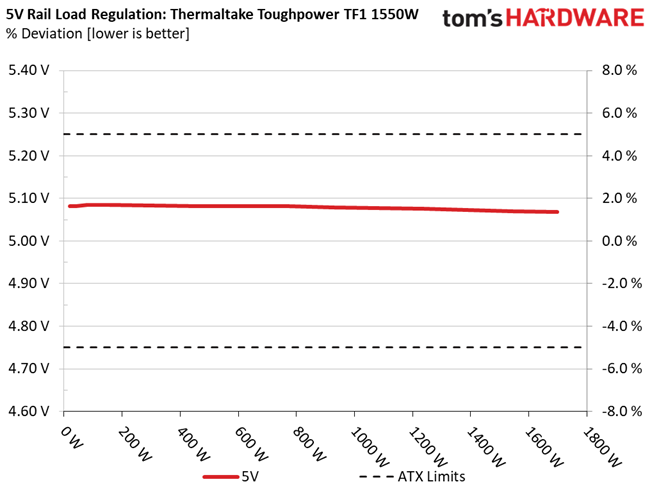
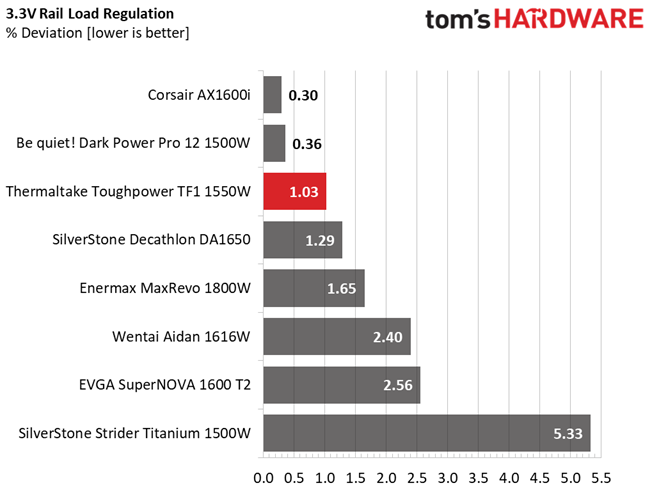
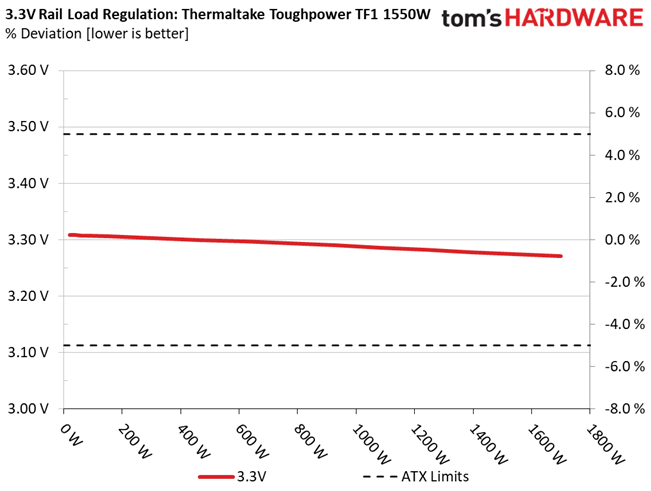
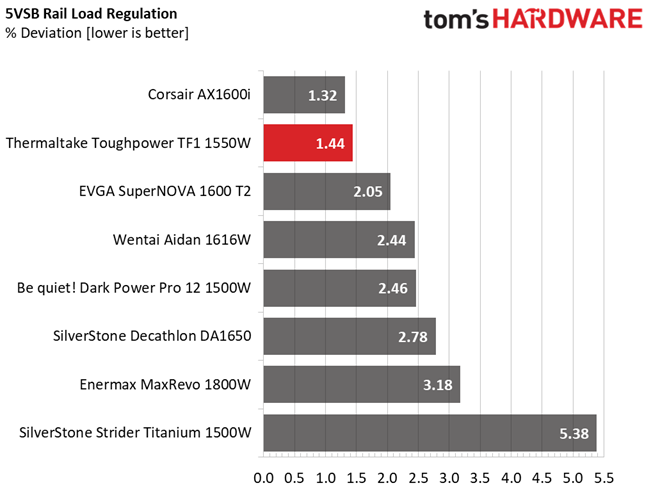

Load regulation is tight enough, if not leading, on all rails.
Hold-Up Time
Put simply; hold-up time is the amount of time that the system can continue to run without shutting down or rebooting during a power interruption.
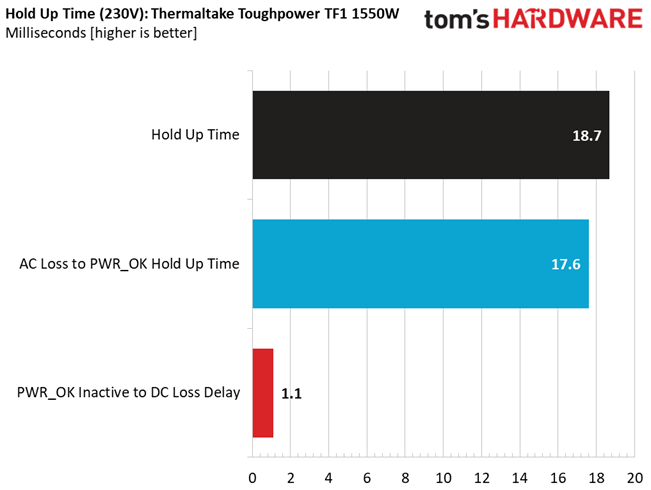
Results 9-12: Hold-Up Time
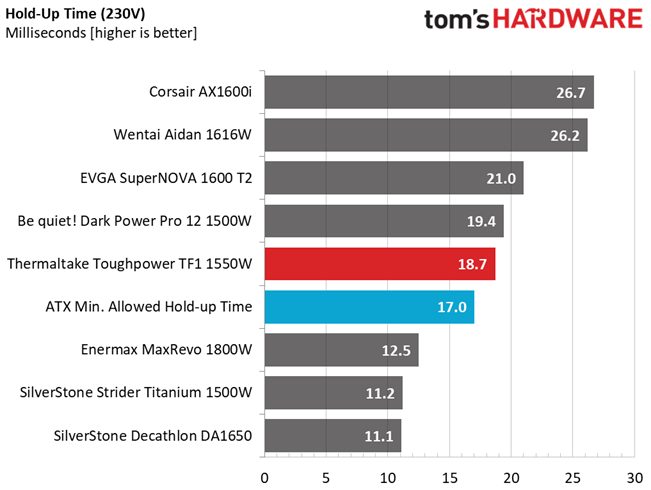
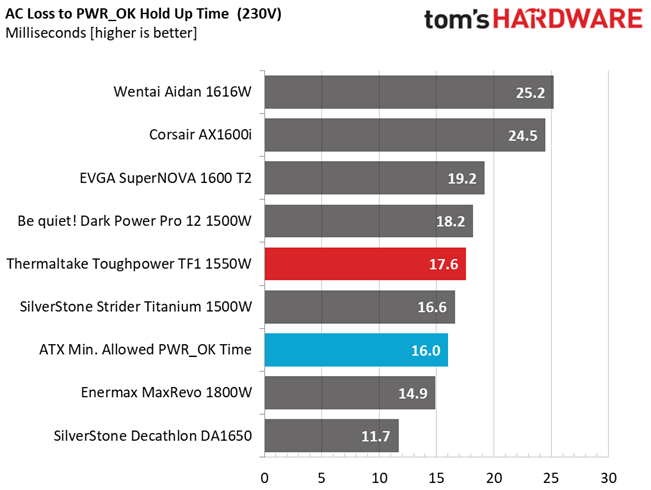
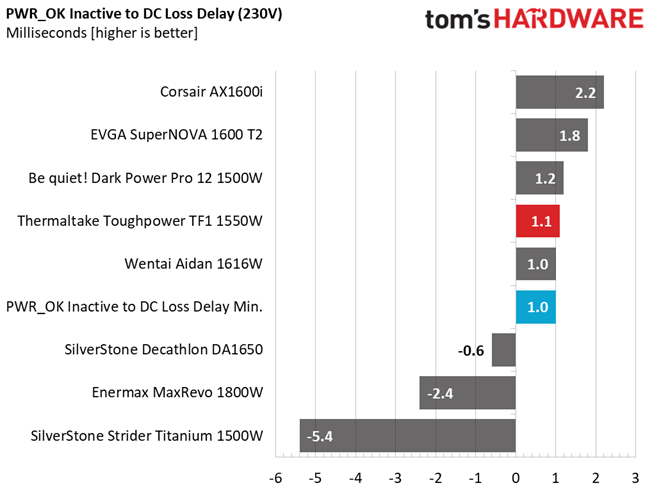
The hold-up time here is close to 19ms. The Dark Power Pro 12 1,500W achieves longer hold-up time, despite the lower combined capacity of its bulk caps. Most likely, it uses a different switching profile.
Inrush Current
Inrush current, or switch-on surge, refers to the maximum instantaneous input current drawn by an electrical device when it is first turned on. A large enough inrush current can cause circuit breakers and fuses to trip. It can also damage switches, relays, and bridge rectifiers. As a result, the lower the inrush current of a PSU right as it is turned on, the better.
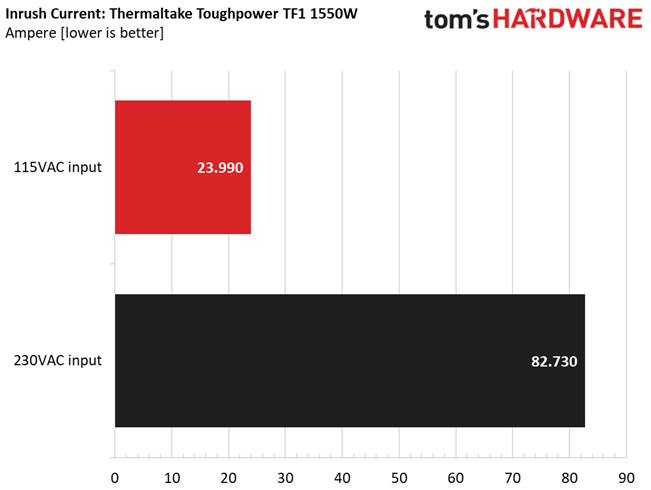
Results 13-14: Inrush Current

Inrush current is low at 115V and at normal levels at 230V, given the overall capacity of the bulk caps.
Get Tom's Hardware's best news and in-depth reviews, straight to your inbox.
Leakage Current
In layman's terms, leakage current is the unwanted transfer of energy from one circuit to another. In power supplies, it is the current flowing from the primary side to the ground or the chassis, which in the majority of cases is connected to the ground. For measuring leakage current, we use a GW Instek GPT-9904 electrical safety tester instrument.
We conduct our leakage current test at 110% of the DUT's rated voltage input (so for a 230-240V device, we conduct the test with 253-264V input). The maximum acceptable limit of a leakage current as defined by the IEC-60950-1 regulation is 3.5 mA, ensuring that the current is low and will not harm any person coming in contact with the power supply's chassis.
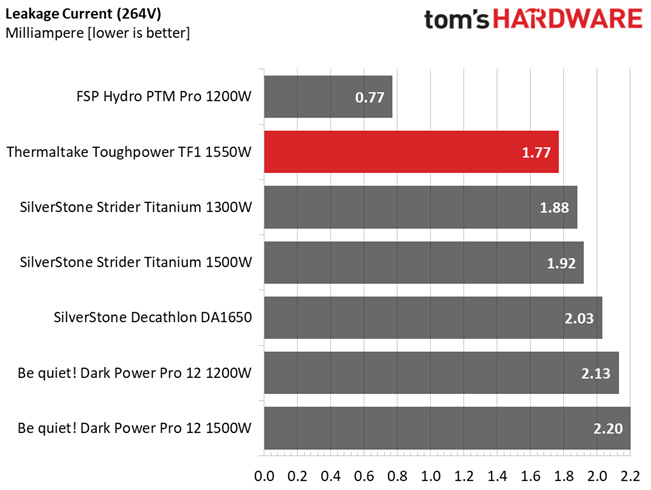
Leakage current is low.
10-110% Load Tests
These tests reveal the PSU's load regulation and efficiency levels under high ambient temperatures. They also show how the fan speed profile behaves under increased operating temperatures.
| Test # | 12V | 5V | 3.3V | 5VSB | DC/AC (Watts) | Efficiency | Fan Speed (RPM) | PSU Noise (dB[A]) | Temps (In/Out) | PF/AC Volts |
| 1 | 11.114A | 1.999A | 2.001A | 1.000A | 155.697 | 91.912% | 308 | <6.0 | 40.08°C | 0.984 |
| 12.044V | 5.084V | 3.306V | 5.062V | 169.397 | 42.88°C | 115.13V | ||||
| 2 | 23.262A | 3.000A | 3.000A | 1.200A | 311.181 | 93.758% | 309 | <6.0 | 40.56°C | 0.995 |
| 12.035V | 5.083V | 3.302V | 5.057V | 331.899 | 44.16°C | 115.12V | ||||
| 3 | 35.759A | 3.500A | 3.501A | 1.400A | 466.444 | 93.914% | 310 | <6.0 | 41.10°C | 0.997 |
| 12.026V | 5.081V | 3.299V | 5.052V | 496.670 | 45.27°C | 115.11V | ||||
| 4 | 48.252A | 4.000A | 4.002A | 1.600A | 621.438 | 93.443% | 310 | <6.0 | 41.27°C | 0.998 |
| 12.017V | 5.081V | 3.297V | 5.047V | 665.045 | 46.15°C | 115.09V | ||||
| 5 | 60.392A | 5.001A | 5.001A | 1.800A | 776.146 | 92.748% | 589 | 14.5 | 42.41°C | 0.999 |
| 12.008V | 5.081V | 3.294V | 5.042V | 836.836 | 48.03°C | 115.08V | ||||
| 6 | 72.542A | 6.003A | 6.000A | 2.000A | 930.588 | 92.090% | 1109 | 34.1 | 42.74°C | 0.999 |
| 11.997V | 5.079V | 3.290V | 5.036V | 1010.521 | 48.89°C | 115.08V | ||||
| 7 | 84.678A | 7.002A | 7.000A | 2.200A | 1084.644 | 91.153% | 1342 | 39.0 | 43.34°C | 0.999 |
| 11.987V | 5.077V | 3.285V | 5.029V | 1189.921 | 50.13°C | 115.06V | ||||
| 8 | 96.826A | 8.002A | 8.000A | 2.401A | 1238.514 | 90.141% | 1537 | 43.0 | 43.66°C | 0.999 |
| 11.976V | 5.075V | 3.282V | 5.023V | 1373.976 | 51.06°C | 115.05V | ||||
| 9 | 109.391A | 8.502A | 8.500A | 2.401A | 1392.022 | 88.921% | 1892 | 48.3 | 44.37°C | 0.998 |
| 11.966V | 5.073V | 3.278V | 5.021V | 1565.466 | 52.54°C | 115.04V | ||||
| 10 | 121.722A | 9.005A | 8.999A | 3.001A | 1545.321 | 87.717% | 2205 | 52.1 | 45.11°C | 0.998 |
| 11.955V | 5.070V | 3.274V | 5.004V | 1761.711 | 54.25°C | 115.03V | ||||
| 11 | 134.643A | 9.004A | 9.000A | 3.001A | 1698.527 | 86.718% | 2205 | 52.1 | 47.28°C | 0.998 |
| 11.946V | 5.068V | 3.271V | 5.002V | 1958.675 | 56.98°C | 115.02V | ||||
| CL1 | 0.121A | 14.005A | 14.001A | 0.000A | 119.310 | 85.791% | 328 | <6.0 | 41.89°C | 0.977 |
| 12.040V | 5.110V | 3.306V | 5.121V | 139.071 | 47.61°C | 115.14V | ||||
| CL2 | 129.184A | 1.000A | 0.998A | 1.000A | 1558.811 | 87.977% | 2055 | 50.4 | 45.52°C | 0.998 |
| 11.963V | 5.069V | 3.281V | 5.040V | 1771.830 | 54.63°C | 115.03V |
This PSU's fan operates at very low speeds up to a 621W load, with the ambient temperature exceeding 41 degrees Celsius. Its highly efficient platform helps in this, since the thermal load doesn't exceed 44W in this scenario.
For us, the fan operated at full speed only during the full load and overload tests, with the ambient temperature being between 45 and 47 degrees Celsius.
20-80W Load Tests
In the following tests, we measured the PSU's efficiency at loads significantly lower than 10% of its maximum capacity (the lowest load the 80 PLUS standard measures). This is important for representing when a PC is idle with power-saving features turned on.
| Test # | 12V | 5V | 3.3V | 5VSB | DC/AC (Watts) | Efficiency | Fan Speed (RPM) | PSU Noise (dB[A]) | PF/AC Volts |
| 1 | 1.240A | 0.501A | 0.501A | 0.200A | 20.163 | 67.912% | 305 | <6.0 | 0.777 |
| 12.051V | 5.082V | 3.308V | 5.077V | 29.690 | 115.13V | ||||
| 2 | 2.472A | 1.001A | 1.001A | 0.400A | 40.215 | 79.876% | 306 | <6.0 | 0.905 |
| 12.050V | 5.082V | 3.308V | 5.073V | 50.347 | 115.13V | ||||
| 3 | 3.712A | 1.501A | 1.501A | 0.600A | 60.362 | 84.896% | 307 | <6.0 | 0.944 |
| 12.049V | 5.083V | 3.307V | 5.070V | 71.101 | 115.13V | ||||
| 4 | 4.952A | 2.000A | 2.002A | 0.800A | 80.507 | 87.732% | 307 | <6.0 | 0.960 |
| 12.048V | 5.085V | 3.307V | 5.068V | 91.765 | 115.13V |
We would like to see over 70% efficiency in the first test and above 80% in the second test. This is a high-capacity PSU, though, so this is not easy to achieve.
2% or 10W Load Test
Intel plans on raising the ante at efficiency levels under ultra-light loads. So from July 2020, the ATX spec will require 70% and higher efficiency with 115V input. The applied load for this test is only 10W for PSUs with 500W and lower capacities, while for stronger units we dial 2% of their max-rated-capacity.
| Test # | 12V | 5V | 3.3V | 5VSB | DC/AC (Watts) | Efficiency | Fan Speed (RPM) | PSU Noise (dB[A]) | PF/AC Volts |
| 1 | 2.377A | 0.266A | 0.266A | 0.055A | 31.142 | 75.729% | 301 | <6.0 | 0.866 |
| 12.047V | 5.073V | 3.304V | 5.070V | 41.123 | 115.14V |
The registered efficiency with a 2% load is quite high on the Thermaltake ToughPower TF1 1,550W, easily exceeding the 70% mark that the newer Intel specifications require.
Efficiency & Power Factor
Next, we plotted a chart showing the PSU's efficiency at low loads, and loads from 10 to 110% of its maximum rated capacity. The higher a PSU’s efficiency, the less energy goes wasted, leading to a reduced carbon footprint and lower electricity bills. The same goes for Power Factor.
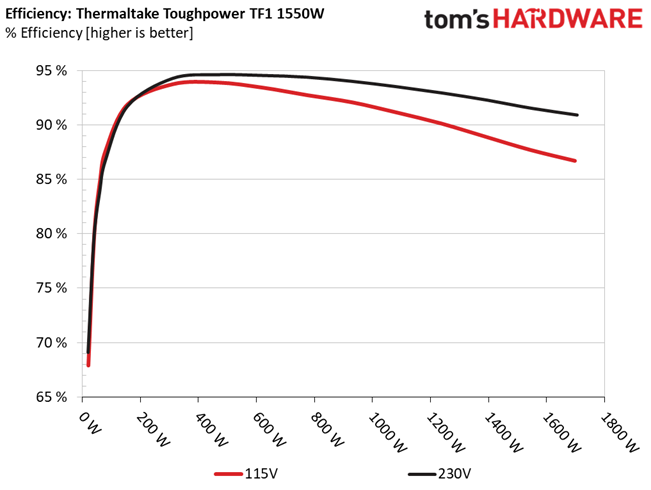
Results 15-18: Efficiency
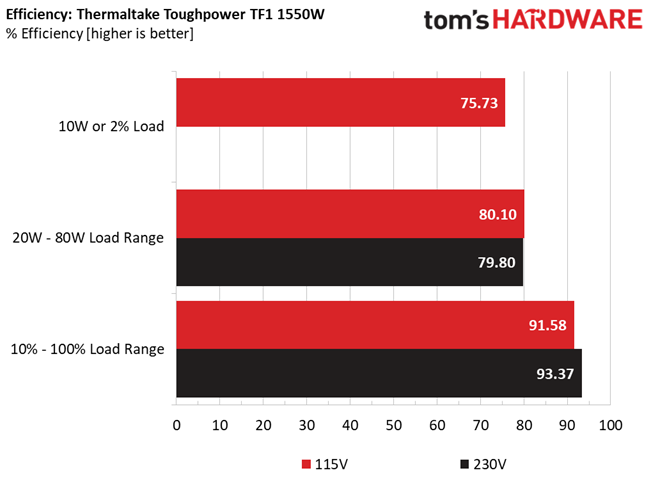
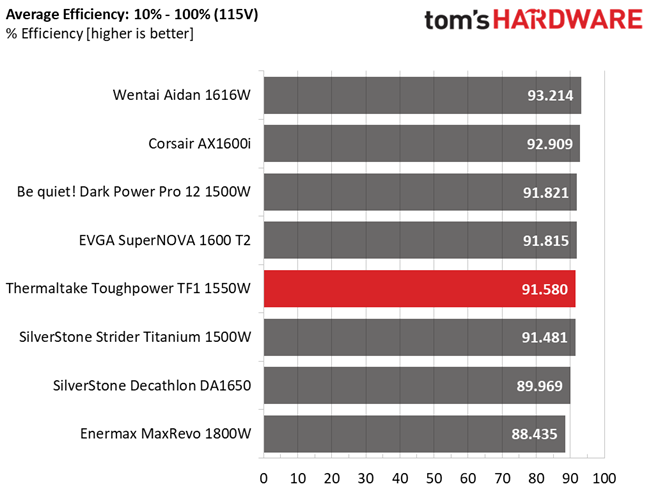
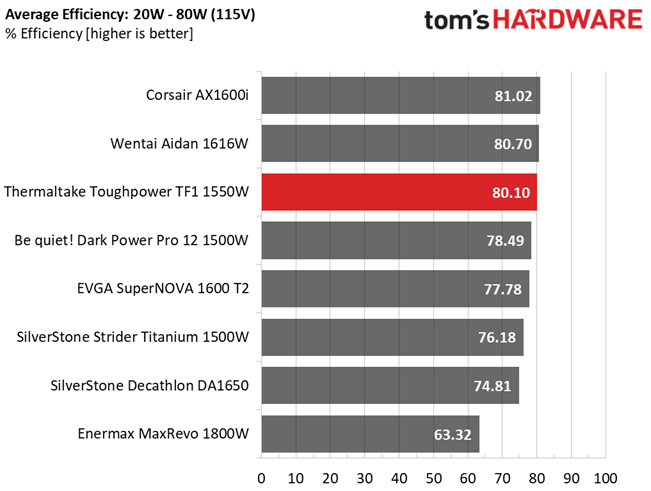
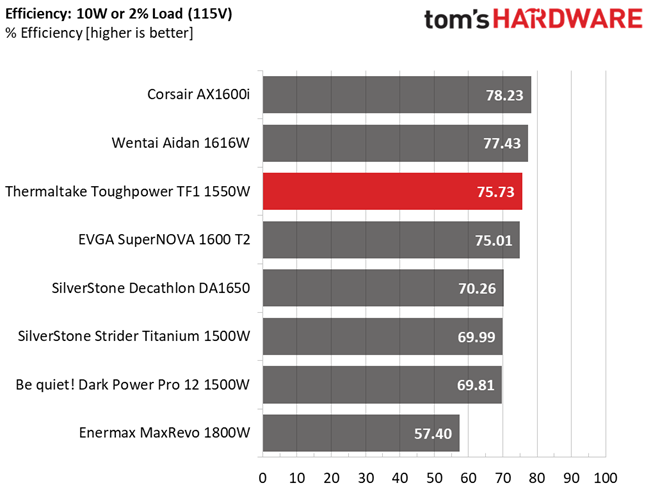
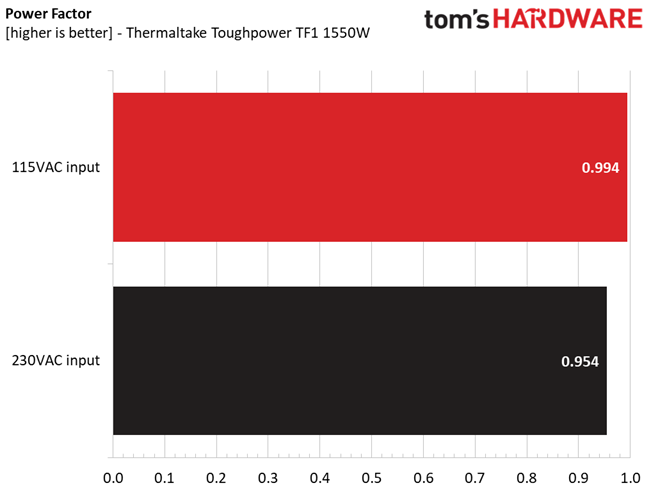
This PSU uses an efficient platform, achieving notably better performance than the Dark Power Pro 12 unit at light loads. Still, it cannot compete with the Corsair and Wentai models, which use a cutting-edge APFC converter.
5VSB Efficiency
| Test # | 5VSB | DC/AC (Watts) | Efficiency | PF/AC Volts |
| 1 | 0.100A | 0.503 | 74.851% | 0.062 |
| 5.031V | 0.672 | 115.11V | ||
| 2 | 0.250A | 1.257 | 77.164% | 0.141 |
| 5.029V | 1.629 | 115.11V | ||
| 3 | 0.550A | 2.763 | 78.294% | 0.256 |
| 5.023V | 3.529 | 115.11V | ||
| 4 | 1.000A | 5.015 | 77.680% | 0.357 |
| 5.014V | 6.456 | 115.11V | ||
| 5 | 1.500A | 7.508 | 77.642% | 0.414 |
| 5.004V | 9.670 | 115.11V | ||
| 6 | 3.001A | 14.927 | 76.963% | 0.488 |
| 4.974V | 19.395 | 115.12V |
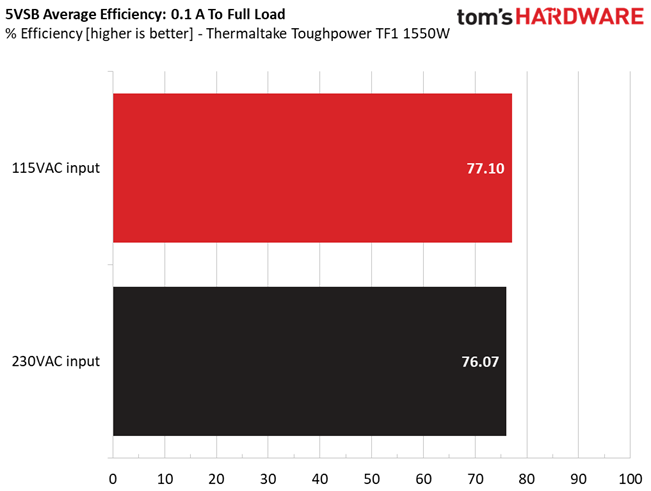
Results 19-20: 5VSB Efficiency
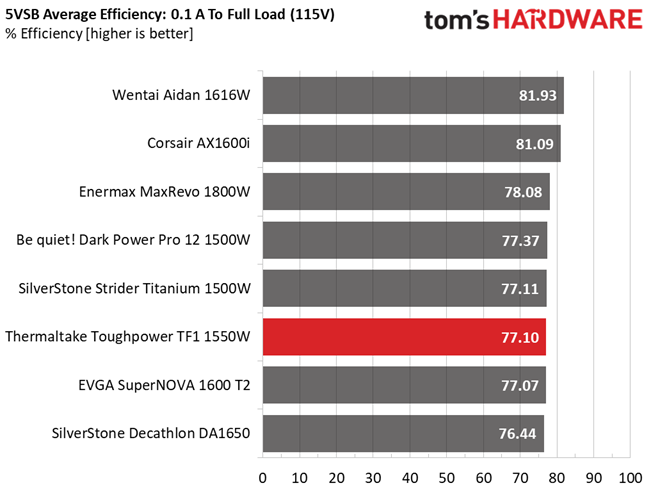
CWT should use a more capable 5VSB circuit. When this PSU is in operation, the 5VSB circuit looks to switch to 5V, which is more efficient.
Power Consumption In Idle And Standby
| Mode | 12V | 5V | 3.3V | 5VSB | Watts | PF/AC Volts |
| Idle | 12.047V | 5.068V | 3.302V | 5.066V | 9.673 | 0.482 |
| 115.1V | ||||||
| Standby | 0.012 | 0.001 | ||||
| 115.1V |
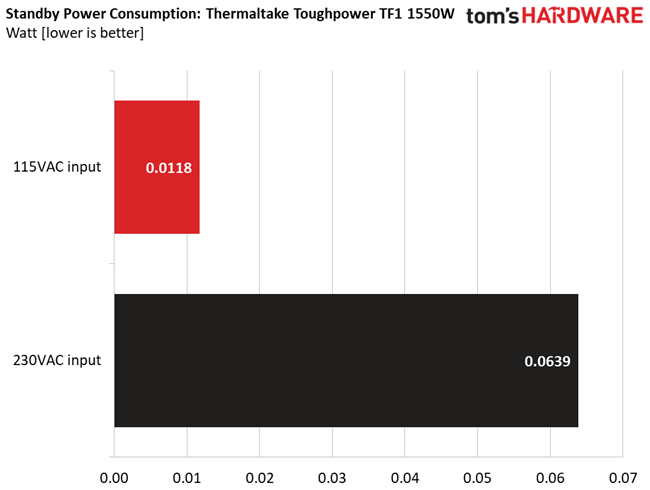
Results 21-22: Vampire Power

Vampire power is dead low, especially with 115V input.
Fan RPM, Delta Temperature, And Output Noise
All results are obtained between an ambient temperature of 37 to 47 degrees Celsius (98.6 to 116.6 degrees Fahrenheit).
Up to a 620W load, this unit's fan speed and noise are extremely low. But the fan's noise exceeds 34 dBA with a 930.6W load, and it goes over 40 dBA at 1,238.5W. This is a high-capacity PSU, though, so we expect it to get loud under stressful conditions.
The following results were obtained at 30 to 32 degrees Celsius (86 to 89.6 degrees Fahrenheit) ambient temperature.
Under normal temperature conditions, noise output is extremely low up to a 750W load, while up to 920W noise doesn't exceed 15 dBA. With higher loads, though, the fan's noise notably increases, exceeding 30 dBA with a 1,025W load, 40 dBA with a 1,260W load, and entering the 45-50 dBA region with loads higher than 1,380W.
MORE: Best Power Supplies
MORE: How We Test Power Supplies
MORE: All Power Supply Content
Current page: Load Regulation, Hold-Up Time, Inrush and Leakage Current, Efficiency and Noise
Prev Page Specifications and Part Analysis Next Page Protection Features, DC Power Sequencing, Cross-Load Tests and Infrared Images
Aris Mpitziopoulos is a contributing editor at Tom's Hardware, covering PSUs.
